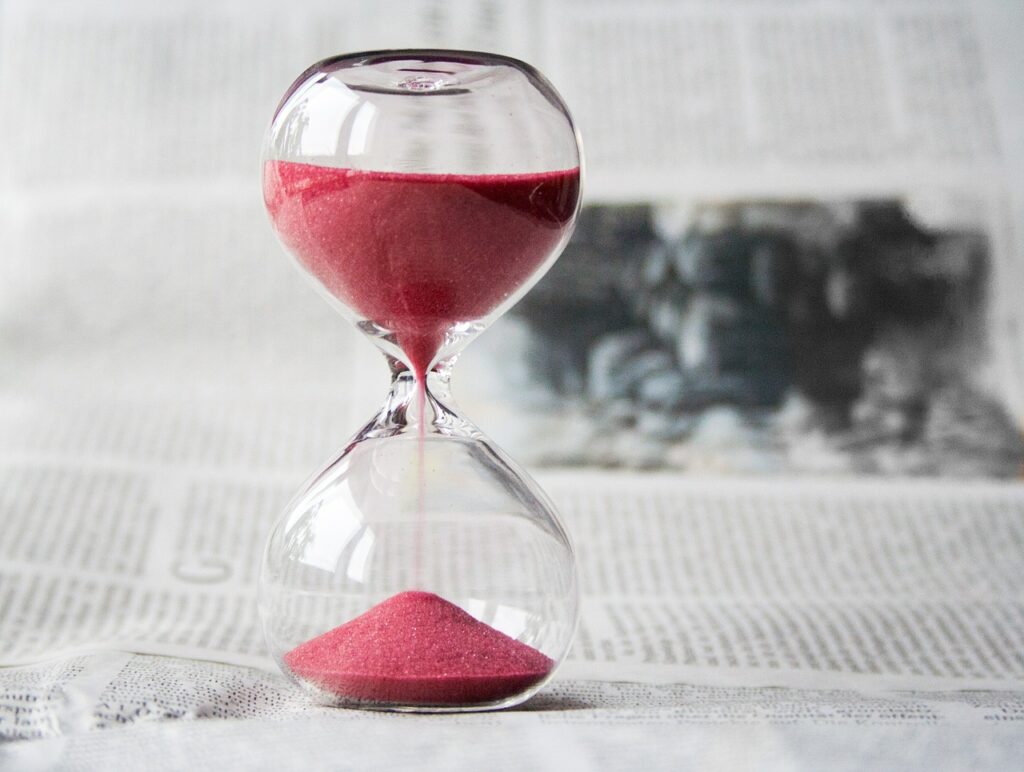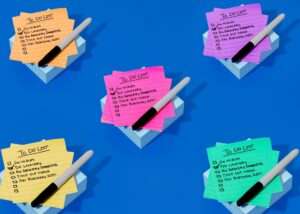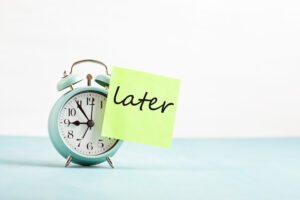
It doesn’t matter what kind of mom you are, whether stay at home, work from home, or in the office, distractions are non-stop.
With kids, meetings, emails, and social media, there is no shortage of interruptions. It can be extremely frustrating to get the ball rolling to then be interrupted again and again. It can make finishing a task feel near impossible.
There are some things you can’t control and then there are the things you can control.
In this post, you’ll discover what’s stealing your focus and 13 tips on how to manage distractions so you can be productive.
Here are my 13 tips and strategies on how to focus and get stuff done in a mom’s world.
1. Avoid long to-do lists
It can be tempting to write an ambitious to-do list because you have high hopes of tearing through it like a boss.
It feels amazing to cross off tasks or put a little checkmark beside them when you’ve completed them. It feels really good. Chances are though, that your list is very long, and you don’t get to check them all off as you hoped.
Don’t feel bad, this is common.
I recommend prioritizing only 1-3 urgent and important tasks for the day. If you can only handle one task, do one thing and move forward.
Be careful with busy work too! Busywork is work that doesn’t produce any meaningful results that might feel productive but aren’t.
It’s the stuff you feel you should do (sometimes out of procrastination too) like checking/organizing paperwork when you’ve done it already, or checking emails for the sake of it.
Creating long to-do lists can also be an example of busywork. If you’re taking more time creating lists you are not taking action.
Figure out your top three priority tasks and focus on those first before anything else.
My recommendations: Any.do
2. Tackle the big task first
You might have heard the quote by Mark Twain, “Eat a live frog first thing in the morning and nothing worse will happen to you the rest of the day.”
This quote inspired others to manage their time and even write books based on it, like the one from Brian Tracy – Eat That Frog!
If you work in an environment with a lot of distractions, it’s best to do your most demanding task first.
The idea is that if you finish the big task first, the rest of the day won’t be as stressful because the worst is done.
It depends on your energy level and if your mind is sharper earlier in the day this might work for you.
This will especially be ideal if you struggle with the afternoon slump. Add the distractions to that and it’s a recipe for not getting it done.
I’ve noticed This is something I’ve noticed myself. My day almost always turns out to be more productive when I do the big and uncomfortable task first.
Try starting the day with tasks in order from hardest to easiest.
My Recommendations:
3. Avoid Multitasking
Multitasking also called task switching can be distracting. You’re switching from one task to another. This slows you down and you risk making needless mistakes. If you make a mistake, you have to go back and fix it, which takes time and energy.
Focusing on one thing at a time is actually more efficient. Stanford University has a good article explaining more about how multitasking can do more harm than good.
You can avoid multitasking (or task switching) simply by making the choice to do one thing at a time. Completing a task before moving on to the next one.
You can also time block by blocking out a chunk of time. Block time for one task before moving on to the next block of time for the next task.
My Recommendations:
The Myth of Multitasking: How “Doing it all All” Gets Nothing Done by Dave Crenshaw
4. Set boundaries and expectations
It’s necessary to set boundaries and expectations at home and at work. The reason may seem obvious but as moms we still give in and sacrifice our time for others.
This is okay within reason, but it should never be at your expense. If you are on a tight deadline for anything whether it be at home or at work, you can’t agree to cutting your deadline even shorter.
If it’s not urgent or important, it can wait.
By setting boundaries, and saying No to things that don’t matter right now, you can focus on what does.
Setting expectations with family, friends, and colleagues about valuing your time can be challenging but it’s necessary. I’ve never met anyone that can read minds, so it’s up to us to be clear and upfront about boundaries and expectations.
My Recommendations:
5. Don’t respond to emails immediately
Do you flinch when you get an email notification? Do you have the habit of checking immediately?
Unless it’s an emergency or requires immediate attention, you don’t need to check or respond to emails immediately.
Think of all the time lost constantly checking email and feeling pressured to respond when not necessary. You can’t get that time back, but you can protect your time moving forward.
Here are three tips to help you manage your emails:
- Set aside dedicated time to check and respond to emails, such as during your lunch break or after your kids have gone to bed. Avoid constantly checking your inbox throughout the day to stay focused on your tasks.
- Prioritize your emails by scanning for urgent messages first, such as work-related emails or messages from your child’s school. Respond to those first and then move on to less important emails.
- Streamline your email management process and save time. For example, you can schedule emails to be sent later, unsubscribe from unwanted emails or setup auto-responses (out of office or vacation) in Gmail or Outlook with just a few clicks.
6. Use App Blockers to help you focus
If you’re working on a task you don’t want to do, procrastination is going to hit hard. Without realizing it, you reach for your phone and scroll social media or go from a promotional email to filling up a shopping cart.
Several minutes have passed, and you say to yourself “Okay, I’m going to really focus now!” but then something comes up and distraction #50 has taken you away from focusing on that task – again.
Sometimes, a little help with self-control is needed.
There are apps that can block applications that steal your attention. Let technology help you minimize distractions and develop discipline.
My Recommendations: RescueTime
7. Use headphones and music
Sometimes we forget the simple solutions. Block out distracting or excessive noise with headphones or calming music.
Unless it’s dangerous to wear headphones where you are, don’t be afraid to use them. If you’re not comfortable with headphones, you can wear noise reducing ear buds like Loop (I have these and they work very well at reducing noise but not blocking entirely.)
It drowns out enough noise (like email notifications, chatter, other annoying noises) so you can concentrate. But not so much that you can’t hear a fire alarm, doorbell, or horn.
My recommendations:
8. Try time management techniques
Distractions can be caused from a lack of time management too.
You might feel the frustration of never having enough time to finish a task or not having a sense of accomplishment at the end of the day.
If this is you, try a time management method like the Pomodoro technique.
The technique uses a timer to break down work into intervals, traditionally 25 minutes in length, separated by short breaks.
Here’s a quick example of what it would look like…
- Start timer for 25 minutes. Work focus until timer goes off.
- Take a 5-15 minute break.
- Start timer again for 25 minutes. Work.
It repeats as long as you need but that is the method. It’s simple and effective.
My Recommendations:
9. Keep your workspace organized
A clear and organized desk or workspace can make a big difference on how well you can concentrate. A workspace that has piles of papers, loose notes and other knickknacks can be a source of distraction.
Use a file organizer or cabinet to keep papers in order so your work surface is clear of clutter.
After clearing your space, make it habit to keep it tidy on a daily or weekly basis as needed.
My Recommendations: Blu Monaco Desk Organizers
10. Know your Chronotype
Everyone has a peak performance time or preference to when they work.
If you’re not sure when it is, you can discover your chronotype.
Chronotype is your natural inclination to be more active and alert at a certain time of day, like being a morning person or a night owl. It’s good to know your chronotype because it affects daily routines and sleep habits, which can impact overall well-being.
It can also optimize routines and improve sleep, leading to more energy and productivity. That’s the goal right?
If you discover or know you’re a morning person, don’t fight it, work with it. Never go against it by forcing yourself to stay up late at night. That’s not sustainable and won’t work.
My Recommendations:
The Power of When: Discover your Chronotype by Michael Breus, PhD
11. Limit Social Media time
Browsing social media can be fun and even informative. But it can also be a major time sink. If your goal is to concentrate and get stuff done, checking social media is not the best way to approach it.
Most people know how much time can slip away when casually scrolling the internet. What you think is going to be a “quick check” or “quick break” can result in an hour or more lost.
That’s a lot of time gone that you can’t get back.
I get it and I’ve done this too. I’m still not resistant to the temptation and I too have to actively block it out during times when I have to focus.
There are a few ways you can manage this.
- Shut down your phone and put it away.
- Turn the computer to focus mode using a blocker.
- Uninstall social media apps on phone.
The last one I admit is extreme but if you have a social media habit that steals your focus and productivity, it might be a good idea to remove them, at least temporarily.
12. Use Cues with family and coworkers
If you’re trying to work with kids at home, you know how hard it is to sit down and focus without interruptions.
It can be helpful to everyone if you establish times during the day where you are interruptible. Put it in a calendar for your spouse and kids to see or write it out on a dry erase board.
Even agreeing on cues that tell family members that you are off limits for the time being like a door sign that reads “Do not disturb”, or when you’re wearing headphones.
It might take a few times to get the point across but when they do, it will get easier.
My Recommendations:
13. Establish good habits and routines
Establishing good habits and routines is key to optimal productivity.
Not having good habits and routines that align with your values and goals will be an open invitation to distractions.
Without a plan for carrying out your daily tasks, you’ll end up spending more time on mundane tasks, which will eat away at the time you need to get other, more important work done.
A routine helps you stay on track and ensures that you make time for the things that matter most.
Use a planner or calendar to schedule your day, and make sure to prioritize your most important tasks.
Avoid multitasking, which can add to more distractions and decreased productivity. Instead, focus on one task at a time and give it your full attention.
Whether you struggle with the habit of scrolling social media or the habit of caving to others demands, developing good habits using the strategies I’ve provided will help you manage distractions more effectively.
My Recommendations:
When you’re a mom with a ton of responsibilities and tight deadlines, distractions will only get in your way of getting things done.
While distractions are inevitable, you can do something about it.
Use the strategies I’ve provided to protect your time and manage the distractions that steal your focus.
You can be productive even as a busy mom, it just takes a different approach and a bit of effort.

39 Fun Indoor Activities For Kids During Winter Break

To-Do List Habits to Break Before 2024

Complete Christmas Planning Guide (4 Week Checklist)

45 Commonly Forgotten Tasks in Preparation for Christmas
7 Simple Ways to Prepare for the Holidays

